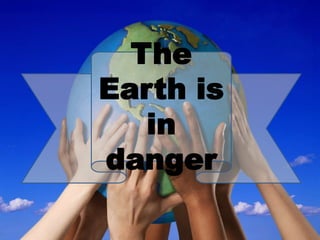
The earth is in danger (2)
- 2. Irina Kostyshyn Lesya Merdukh Creative team
- 3. • Deepen and broaden children's knowledge about the impact of humans on nature. Bring the children to realize the need to preserve and promote natural resources rationally use them. • Develop: cognitive interest, cognitive activity; language; observation; creative abilities of students; ability to find, analyze, organize information and use it; ability to work in a group. • Train heed economic relationship to nature, as his home, the desire to save the planet Earth for future generations, love of nature, environmental literacy and awareness that the Earth - our common home. Purpose
- 4. Environmental protection has become one of the most difficult problems 20 centuries. Our planet gives people the natural resources, rivers, forests, fields that is the basis of all industrial and agricultural production. Industrial development is bad for the whole nature of our world. Industry people are often very polluting land and water. This is very dangerous because it is harmful to health. Topicality
- 8. Soil erosion - is the destruction of his upper horizon and fertile ground by natural and anthropogenic factors (mechanical destruction of its kinetic action of water (flow of shots and drops) or wind flows). Soil erosion
- 10. Acid rain o Acid rain - widely used term that indicate the occurrence of rainfall, which contain a mixture of water and tiny particles of nitrogen oxide or sulfur oxide concentrations that exceed normal natural background. Vivacious use of resources of the planet, large scale combustion, environmentally imperfect technology - clear signs of rapid industrial development that eventually accompanied by chemical pollution of water, air and land. Acid rain - just one manifestation of such pollution.
- 11. The weakening of the ozone layer increases the flux of solar radiation on the ground and causing people increasing number of skin cancers. Also, elevated levels of radiation affected plants and animals.
- 12. Air pollution - one of the main types of anthropogenic pollution. Is to release into the atmosphere of chemicals, particulate matter and biological materials that can cause harm to humans and other organisms. Often the effect of pollution is indirect and evident only after a long time, for example, certain substances can reduce the thickness of the ozone layer, thus impacting on most terrestrial ecosystems.